3 min read
Mass Timber Projects Gaining Ground & Reaching New Heights
John Greene
:
December 29, 2017
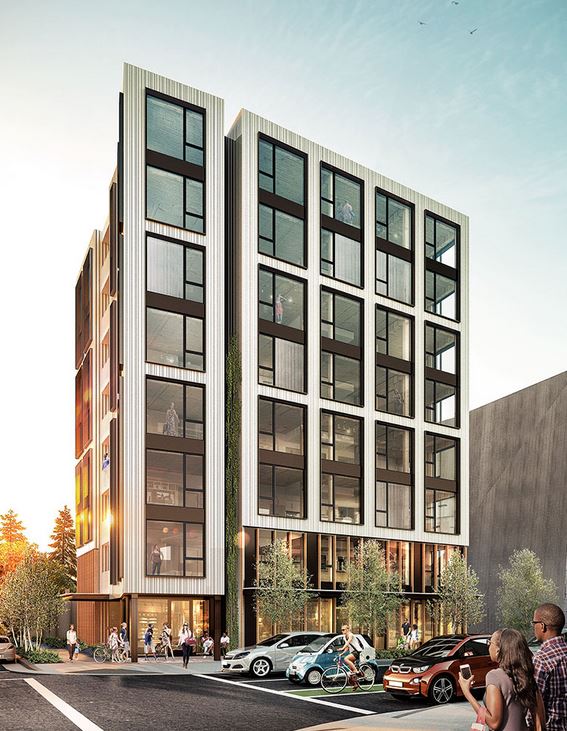
Two milestone North American mass timber projects are demonstrating that wood is still an incredibly versatile and reliable building material that will play an important role in the 21st century. As green building codes become more commonplace with the assistance of programs like the Leadership in Energy and Environmental Design (LEED) building rating and certification structure, various types of manufactured wood products, including cross-laminated timber (CLT), will become more prevalent building materials.
With the recent passage of the Resilient Federal Forests Act in the House of Representatives, the wood products industry is also one step closer to gaining real momentum in large-scale construction projects. Subtitle C, Sec. 922 of the bill includes details that will facilitate the further development of innovative wood products, or any building component or system that uses large panelized wood construction, including mass timber. The bill specifies that, “The Secretary [Secretary of Agriculture Perdue] shall conduct performance-driven research and development, education, and technical assistance for the purpose of facilitating the use of innovative wood products in wood building construction in the United States.”
American Wood Council president and CEO Robert Glowinski added that, "This bill includes language directing the technical assistance and research components already in place at the U.S. Department of Agriculture to facilitate the use of these innovative wood products into mainstream construction through research and development, education, and technical assistance. Supporting mass timber construction is a win-win because it would introduce new carbon-neutral building materials to our urban areas, as well as job creation in rural areas."
Carbon12 Project in Portland
Per a recent article in The Architects Newspaper (AN), Portland, Oregon is now home to the tallest timber building in the US. Carbon12 is the newly-finished, 85-foot tall (eight story) mixed-use building, which was designed by PATH Architecture.
The AN article notes that “Carbon12 features a mix of 14 residential units, each with their own recessed balcony, as well as retail on the ground floor and a mechanized underground parking system. While the exterior is clad in vertically striated metal paneling that recalls timber grain, PATH chose to accentuate the natural materials of the interior spaces by leaving the wood columns, beams, and undersides of the CLT slabs exposed for a warmer feel.”
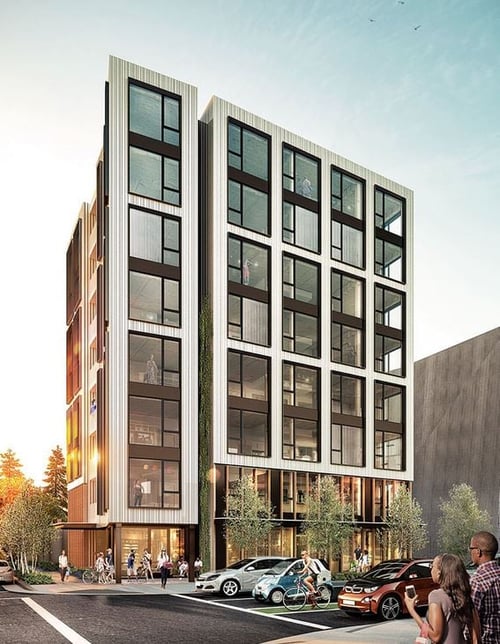 Exterior of Carbon12 building in Portland, OR. Source: PATH Architecture
Exterior of Carbon12 building in Portland, OR. Source: PATH Architecture
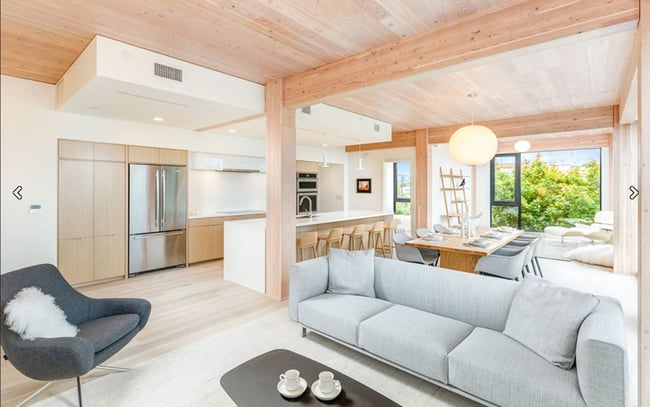
Interior of Carbon12 unit living room in Portland, OR. Source: PATH Architecture
PATH designed Carbon12 to be built with a mix of glulam beams and CLT surrounding a central steel core, and the finished building also includes solar panels on the roof. PATH focused specifically on incorporating sustainability in the project; locally grown timber sequesters more carbon than is used to grow and transport the wood, it has a smaller carbon production footprint than steel or concrete and the prefabricated CLT panels provided a construction speed advantage over traditional steel and concrete materials.
CLT is becoming an increasingly-attractive building material, especially in regions with access to high-quality timber resources. It is composed of three, five or seven layers of dimensional lumber stacked perpendicularly and glued together to create heavy-duty structural panels. Because they offer two-way span capabilities, CLT panels can be used for flooring, walls and roofs, and the result is a material that is lightweight, strong, efficiently transported and less labor intensive than many other construction materials.
While Carbon12 is currently the tallest timber building in the US, it won’t be for long. The 148-foot tall, 12-story Framework building (also in Portland) is slated to be finished in winter of 2018.
Arbora Complex in Montreal
A timber-based complex including three, eight-story buildings totaling nearly 600,000 square feet, the Arbora Complex near downtown Montreal is currently one of the largest mass timber projects in the world. When completed, the project will include 273 condominiums, 30 townhouses and 130 rental units for a total of 434 residential units. The Arbora development will also distinguish itself by dedicating 40 percent of its total area to “green space” in its quest to achieve LEED Platinum certification.
Arbora is being constructed with CLT provided by Nordic Structures, a Quebec-based company that is also supplying other project services. Arbora’s buildings are designed around a grid system of CLT beams and panels that allow for an efficient manufacturing and shipping process, as well as quick on-site assembly.
According to Nordic’s US Market Development Manager Jean-Marc Dubois, “With mass timber structures, you can use less employees and get more work done. There’s a shortage of skilled labor across North America, so the fact that you can raise structures with considerably less skilled employees is very critical. Typically we operate with as few as four to six tradespeople on a jobsite. The output per person is much greater.”
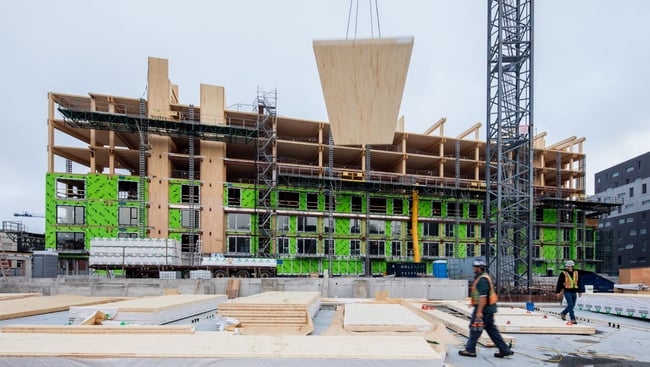
Construction using CLT at the Arbora Complex in Montreal, Quebec. Source: Nordic Structures
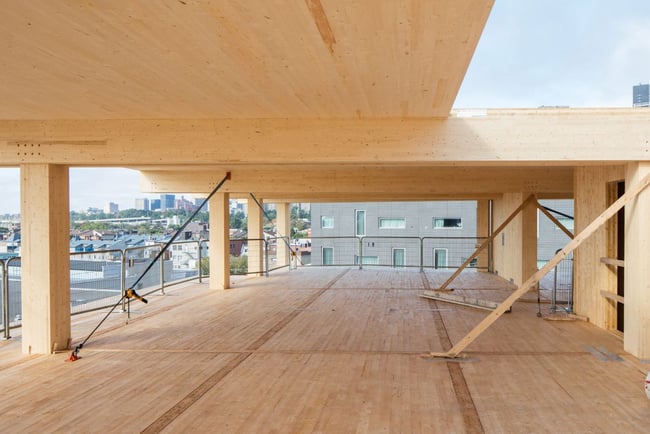
Construction using CLT at the Arbora Complex in Montreal, Quebec. Source: Nordic Structures
“The key to Arbora’s commercial success in a competitive housing market is design efficiency, and an acknowledgement of the inherent structural properties of CLT from the outset of a project. There are efficiency gains in replication,” Dubois added. “There’s a lot of press surrounding high-rise wood construction, but Arbora shows there’s a place for affordable, viable mid-rise construction.”
Modern technology—which is helping to develop new construction materials such as CLT and other mass timber products—demonstrates that wood-based building materials are cost-effective and widely available, durable, versatile and much more environmentally friendly than many other building materials. As these materials make it possible to build timber structures higher and higher—especially with US legislative support and growing market demand—projects like Carbon12 and Arbora are paving the way for the eventual acceptance of timber as a mainstream urban construction material.





